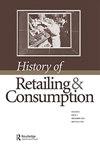Steering the free market through a food crisis? Fiscal policy and meat consumption in Brussels during the 1840s
Q2 Arts and Humanities
引用次数: 0
Abstract
ABSTRACT By the 1840s the Brussels city council had become distinctly liberal in its approach to the economy. Even the meat sector, once uniquely intensely regulated by urban authorities, had shed almost all early modern regulation and was largely left to the free market. However, the 1840s subsistence crisis and rising food prices increased pressure on lawmakers to intervene. This paper explores how, rather than returning to older consumer-protecting limits on the market such as price-setting, the council used its fiscal authority to ease its citizens’ burden. What appears from discussions on taxation is a great willingness to try to influence the free market through changing tax rates in favour of the interest of poor and labouring consumers. Unlike the shift from prices to health the literature suggests (Horowitz, Pilcher and Watts [2004]. “Meat for the Multitudes: Market Culture in Paris, New York City, and Mexico City over the Long Nineteenth Century.” The American Historical Review 109, no. 4 (October 2004): 1055–1083. doi:10.1086/530749), this consumer interest was interpreted as relating both to meat prices and meat quality and salubriousness. While the explicit focus on urban consumers was new, many arguments repeated early modern concerns of greedy butchers preying on poor consumers, with price and health as twin priorities. The new liberal regime, facing crisis, used new tools, but traditional discourse and conceptions of government responsibility persisted.在粮食危机中驾驭自由市场?19世纪40年代布鲁塞尔的财政政策和肉类消费
摘要到19世纪40年代,布鲁塞尔市议会在经济方面变得明显自由。即使是曾经受到城市当局独特严格监管的肉类行业,也几乎摆脱了早期所有的现代监管,在很大程度上留给了自由市场。然而,19世纪40年代的生存危机和不断上涨的食品价格增加了立法者进行干预的压力。本文探讨了委员会如何利用其财政权力来减轻公民的负担,而不是回到价格制定等保护老年消费者的市场限制。从税收讨论中可以看出,人们非常愿意通过改变税率来影响自由市场,以利于穷人和劳动消费者的利益。与文献表明的从价格向健康的转变不同(Horowitz,Pilcher和Watts[2004]。“多元肉类:漫长的十九世纪巴黎、纽约和墨西哥城的市场文化”。《美国历史评论》109,第4期(2004年10月):1055–1083。doi:10.1086/530749),这种消费者兴趣被解释为与肉类价格、肉类质量和健康有关。虽然明确关注城市消费者是新的,但许多论点重复了早期现代的担忧,即贪婪的屠夫捕食贫穷的消费者,价格和健康是双重优先事项。面对危机的新自由主义政权使用了新的工具,但政府责任的传统话语和概念仍然存在。
本文章由计算机程序翻译,如有差异,请以英文原文为准。
求助全文
约1分钟内获得全文
求助全文
来源期刊

History of Retailing and Consumption
Arts and Humanities-History
CiteScore
0.50
自引率
0.00%
发文量
3
 求助内容:
求助内容: 应助结果提醒方式:
应助结果提醒方式:


